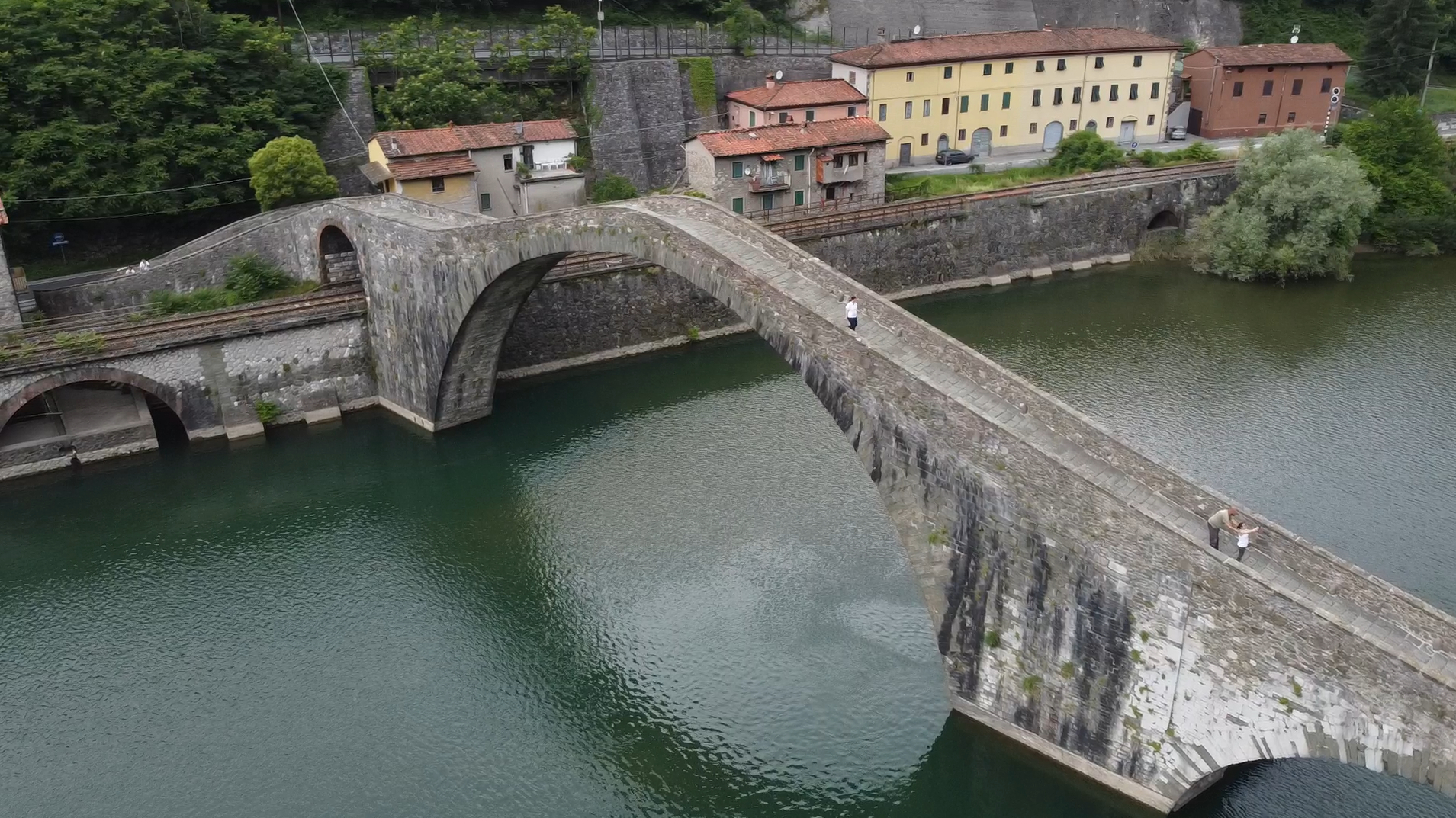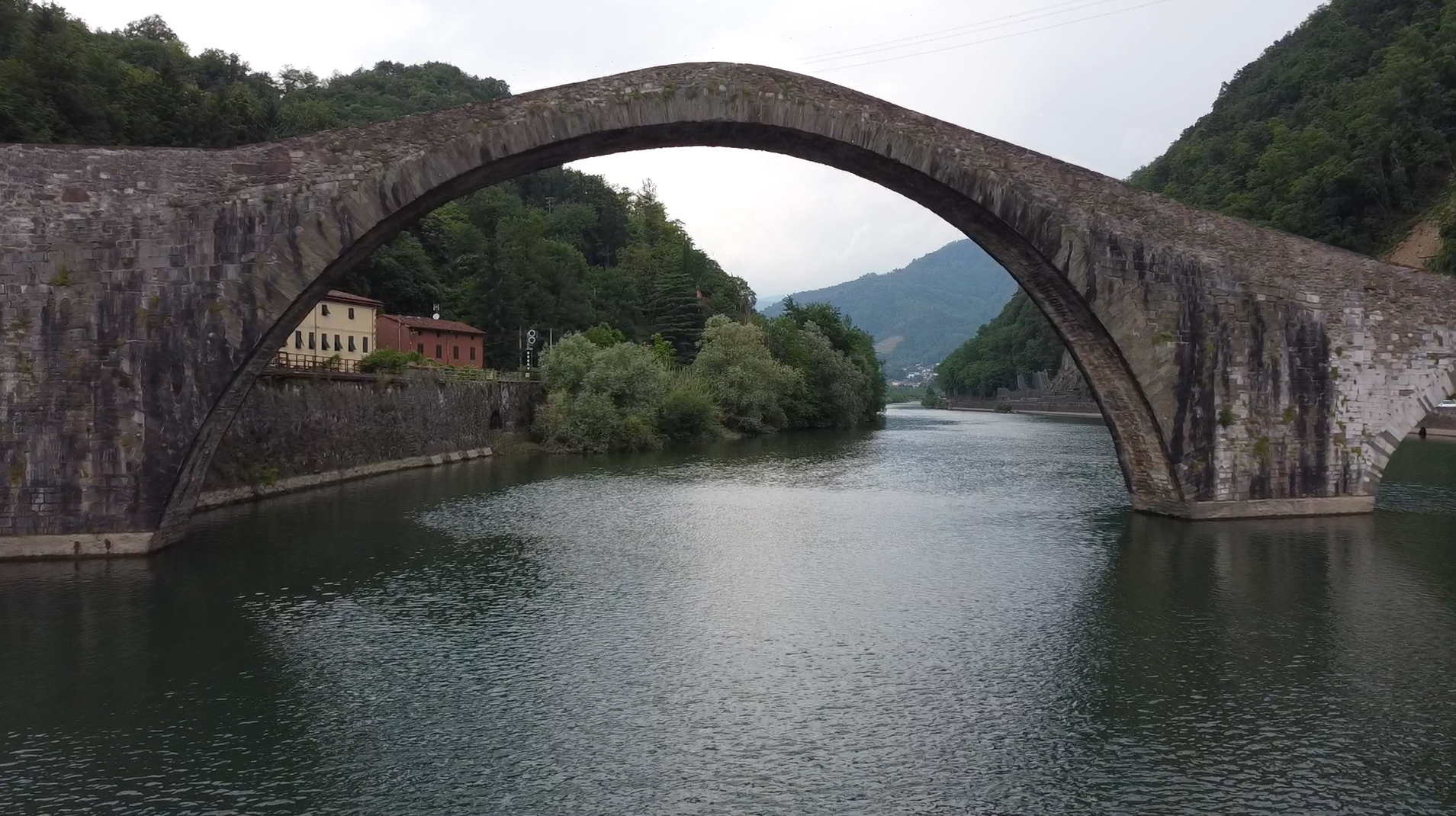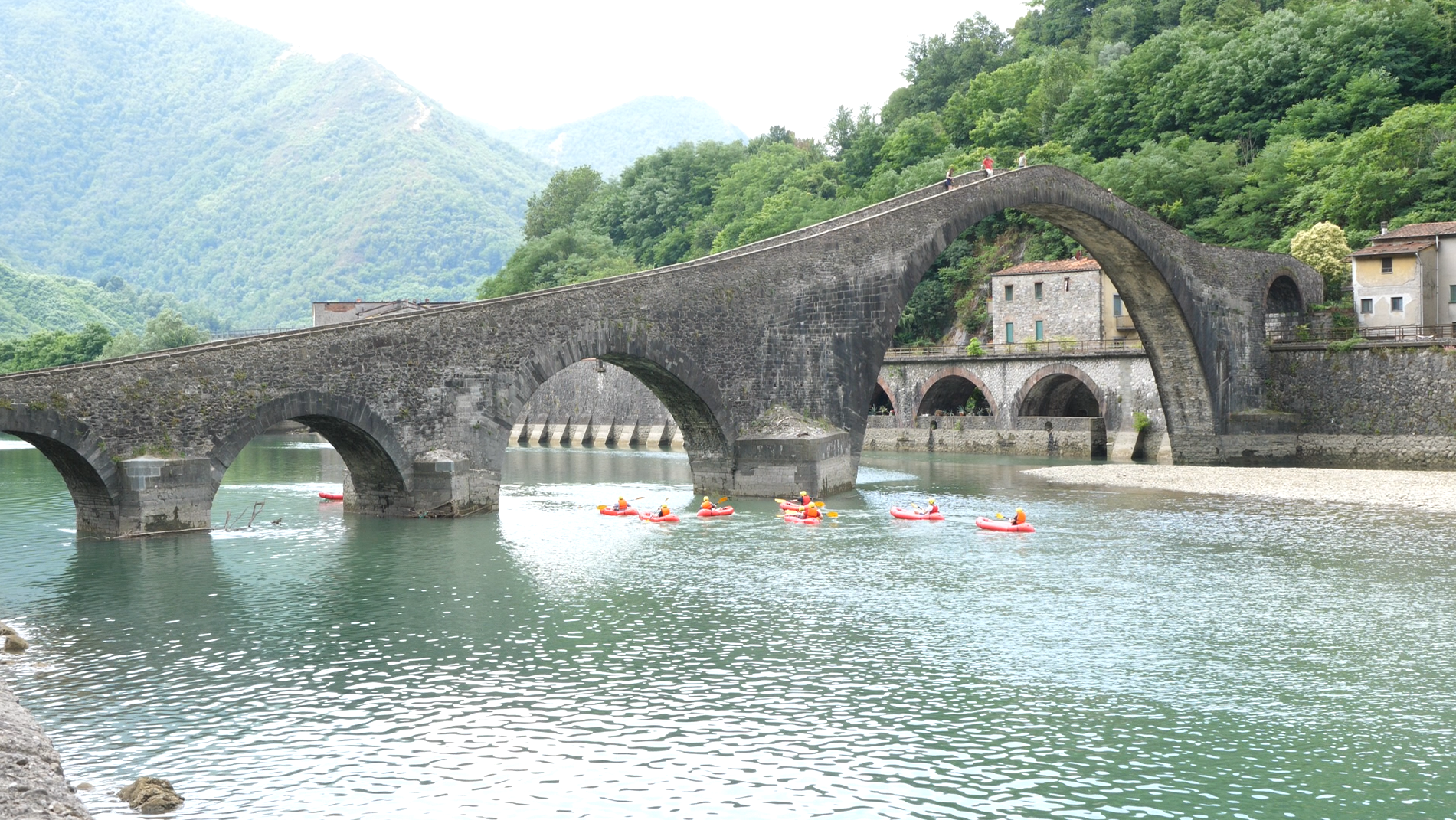
When you get to Borgo a Mozzano, you cannot help but remain awestruck by the Maddalena Bridge better known as the Devil’s Bridge. With its legendary origins and its humpback shape, a testament to great creative intuition, it is the gateway to the Serchio River Valley. There are several devil bridges throughout Europe, each with its own legend often tied to local beliefs.
In the past, bridges were quite rare and when they connected the banks of very large rivers or had daring shapes, they evoked amazement and the belief that the work could not have been done by human hands alone.
This has been the case since Roman times when Julius Caesar had a wooden bridge built across the Rhine River, which he later destroyed. The Germans consequently stopped raiding Gallia for a long time because they believed that an army capable of such work
was not to be underestimated.
Devil bridges, built in the Middle Ages for the most part generally in masonry or stone, were made using quite an advanced technology given the period of construction. These bridges have a so-called humpback shape characterized by a round arch as wide as possible to connect the two opposite banks of the river, automatically increasing the height of the arch.
At Borgo a Mozzano, the main arch is 36.8 meters high. Since ancient times, the territory of Borgo a Mozzano was an important crossroads for merchants, adventurers, and pilgrims traveling through a territory full of unexpected occurrences and difficulties. To
improve access to the area, in the Middle Ages, a bridge was built in Borgo a Mozzano to connect the two banks of the Serchio River.
Tradition attributes the construction of a first bridge to Matilda of Canossa, but there are no documents to support this. Until the second half of the nineteenth century, it is reported that there was a plaque on the last pier of the bridge inscribed with the year
1101, the time of Matilda of Canossa. The date was written in Arabic numerals and this proves that the plaque could not be from the twelfth century since Roman numerals were still being used in that time period.

The biographers of Castruccio Castracani degli Antelminelli provided more reliable information. Between 1324 and 1327, Castruccio had several bridges built across the Serchio River, including, most likely, the bridge at Borgo a Mozzano. It is probable that the
construction of the bridge took place over time by different constructors.
Building over the river was certainly not easy and probably the course of the Serchio was diverted first on one side and then on the other side of its bed to allow the construction of the bridge. In the Middle Ages, safety was a big problem and often bridges were built not only in stone but there was a section in wood that could be quickly destroyed in case of an enemy attack. So it is thought that even the bridge at Borgo a Mozzano, initially, was part masonry and part wood, subsequently modified and made entirely of stone.
The piers of the bridge rest on the only points of the river where there is a sufficiently solid rock base, perhaps this is why the arches are of different widths. The question that frequently arises is who could have made such a majestic bridge so long ago? The
answer is….why, the devil, of course!
There are several versions of the legend and the most accepted one tells of Saint Julian (Giuliano), probably Saint Julian the Hospitaller, patron saint of travelers, who lived in the sixth century and encountered difficulties while constructing the bridge. He therefore accepted the devil’s help who promised to complete the bridge overnight on one condition: he wanted the soul of the first being to cross it. The saint accepted the agreement and upon completion, Saint Julian coaxed a dog with food and made it cross
the bridge and the devil was forced to take the dog’s soul.
The tale ends with the devil who, infuriated by the people’s mockery, throws himself off the bridge into the waters of the Serchio, never to be seen again.
In 1526, on the left side of the bridge a hermitage was built dedicated to Saint Mary Magdalene (Santa Maddalena), which is why, even today, the bridge is called Maddalena Bridge.

At the end of the nineteenth century, the director of the Lucca-Aulla rail line advised the town council of Borgo a Mozzano that it would be necessary to sacrifice the legendary and historical monument for the public good and allow an alteration to the original
harmonious line of the bridge on the right hand side of the river to permit the passage of the railroad.
Despite the fact that a previous project existed where the rail line passed on the left bank of the river from Anchiano, the town council approved the request of the director of the Lucca-Aulla line, fifteen votes in favor, six against. On July 15 1898, the rail line Borgo a Mozzano-Bagni di Lucca was inaugurated. Sebastiano de Navasques wrote: “And now this bridge, full of old memories, the only one of its kind on our river, that had preserved its beautiful original structure so grandiose in its strangeness, this wonderful bridge that floods respected and spared almost bowing to its magnificence and old age, today, by the hand of man, is disfigured and knocked down. The last arch on the right side of the river has been filled and dismantled, the embankment has been raised, so the steam engine can pass under it, a message for those populations of material well-being, today destroyers, in that spot, of the greatest work of art that existed exclusively on our river.”
Then in 1948, a short distance from the bridge, along the river toward Lucca, a dam was built creating an artificial basin in the area of the bridge.
Over the centuries, many artists have portrayed the Devil’s Bridge of Borgo a Mozzano with prints, paintings, etchings, woodcuts, and sculptures. The first print dates to 1521 by the Flemish painter Hendrix Van Cleve. In 1581, there is a literary reference by Michel de Montaigne in his Journal de Voyage, written to document his trip to Italy. He crossed the bridge while staying in Bagni di Lucca where he remained for seventy-four days to cure stone sickness, as kidney stones were called back then.
Montaigne, who was more interested in human beings and rarely evaluated works created by them, was fascinated by the bridge at Borgo a Mozzano, describing it as: “of unusual height, with a very high arch embracing a great width of river: we saw three or four such
bridges”.

Through the centuries, the Devil’s Bridge has resisted countless floods, such as the one in 1982, when the river water rose to completely cover the lower arches of the bridge.
The bridge miraculously survived even the Second World War. Although it had been mined by the Germans as they retreated toward the northern line of the Gothic Line in upper Garfagnana, they did not detonate the charges. For the Allied Forces, the bridge was useful to transport material to the other side of the river in order to build a military Bailey bridge just a few meters away in the direction of Chifenti. The majority of the troops and the various vehicles were thereby able to cross the river despite the destruction of the Pari Bridge. At the end of the conflict, before the reconstruction of the Pari Bridge, the Devil’s Bridge was, for years, the only passage over the Serchio River at Borgo a Mozzano.
Still today, the origins of the bridge are shrouded in mystery between legends and history.
The Devil’s Bridge unites the past and the present of the community of Borgo a Mozzano and is one of its best-loved symbols.
Text created for the Municipality of Borgo a Mozzano